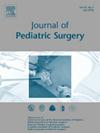腹腔镜与开放式儿童腹股沟疝气修复术的全国回顾性比较。
IF 2.4
2区 医学
Q1 PEDIATRICS
引用次数: 0
摘要
背景:在过去十年中,腹腔镜腹股沟疝修补术的使用率显著增加。本研究的目的是在全国范围内比较开腹和腹腔镜腹股沟疝修补术后的二次疝气手术率和同侧复发率:这项回顾性分析利用儿科健康信息系统数据库来识别患儿:我们确定了53287例手术(15.6%为腹腔镜手术)。腹腔镜修复术后二次疝气手术率更高(2.9% vs 2.6%,P = 0.04),多变量分析结果显示两者无差异(OR 1.14,95% CI 0.98-1.32)。腹腔镜修复术后同侧复发率更高(1.5% 对 0.4%,P=0.04):儿童腹股沟疝气腹腔镜修补术的同侧疝气复发率是开放式修补术的三倍多,但由于异位疝气的二次手术率降低,两者相抵:治疗研究 - III 级。本文章由计算机程序翻译,如有差异,请以英文原文为准。
A Retrospective Nationwide Comparison of Laparoscopic vs Open Inguinal Hernia Repair in Children
Background
Utilization of the laparoscopic approach for inguinal hernia repair has increased significantly over the past decade. The purpose of this study is to compare rates of second hernia operation and same side recurrence following open and laparoscopic inguinal hernia repair in a large national cohort.
Methods
This retrospective analysis utilized the Pediatric Health Information System database to identify children <18 years-old who underwent laparoscopic or open primary inguinal hernia repair from 2017 to 2021. Data were collected through 2022 to allow minimum one year follow-up. Second hernia operation rates, inclusive of same side recurrence and metachronous contralateral hernia, and same side recurrence rates were compared by multivariable mixed effects model controlling for confounders and institutional clustering. Misclassification rates were determined through data validation at four constituent institutions. Sensitivity analyses determined true outcome rates.
Results
We identified 53,287 operations (15.6% laparoscopic). Rate of second hernia operation was greater following laparoscopic repair (2.9% vs 2.6%, p = 0.04) with no difference on multivariable analysis (OR 1.14, 95% CI 0.98–1.32). Same side recurrence rate was greater following laparoscopic repair (1.5% vs 0.4%, p < 0.001) which persisted on multivariable analysis (OR 3.72, 95% CI 2.90–4.78). Sensitivity analysis demonstrated true laparoscopic and open repair rates of 14.2% and 85.8%, respectively. True rates of second hernia operation and same side recurrence were identical to those determined by PHIS.
Conclusion
Laparoscopic inguinal hernia repair in children has more than three times the odds of same side hernia recurrence than open repair which is balanced by a reduced rate of second operation for metachronous hernia.
Level of evidence
Treatment Study – Level III.
求助全文
通过发布文献求助,成功后即可免费获取论文全文。
去求助
来源期刊
CiteScore
1.10
自引率
12.50%
发文量
569
审稿时长
38 days
期刊介绍:
The journal presents original contributions as well as a complete international abstracts section and other special departments to provide the most current source of information and references in pediatric surgery. The journal is based on the need to improve the surgical care of infants and children, not only through advances in physiology, pathology and surgical techniques, but also by attention to the unique emotional and physical needs of the young patient.

 求助内容:
求助内容: 应助结果提醒方式:
应助结果提醒方式:


